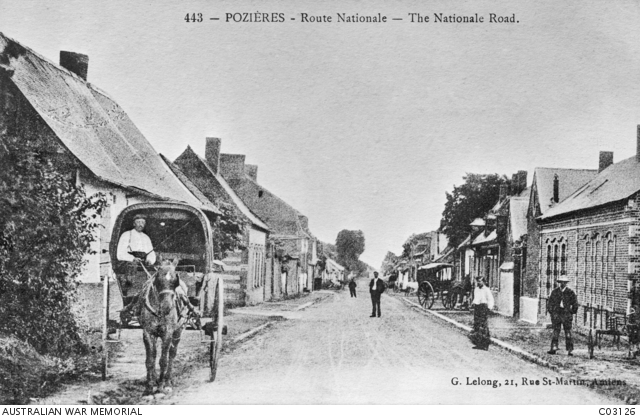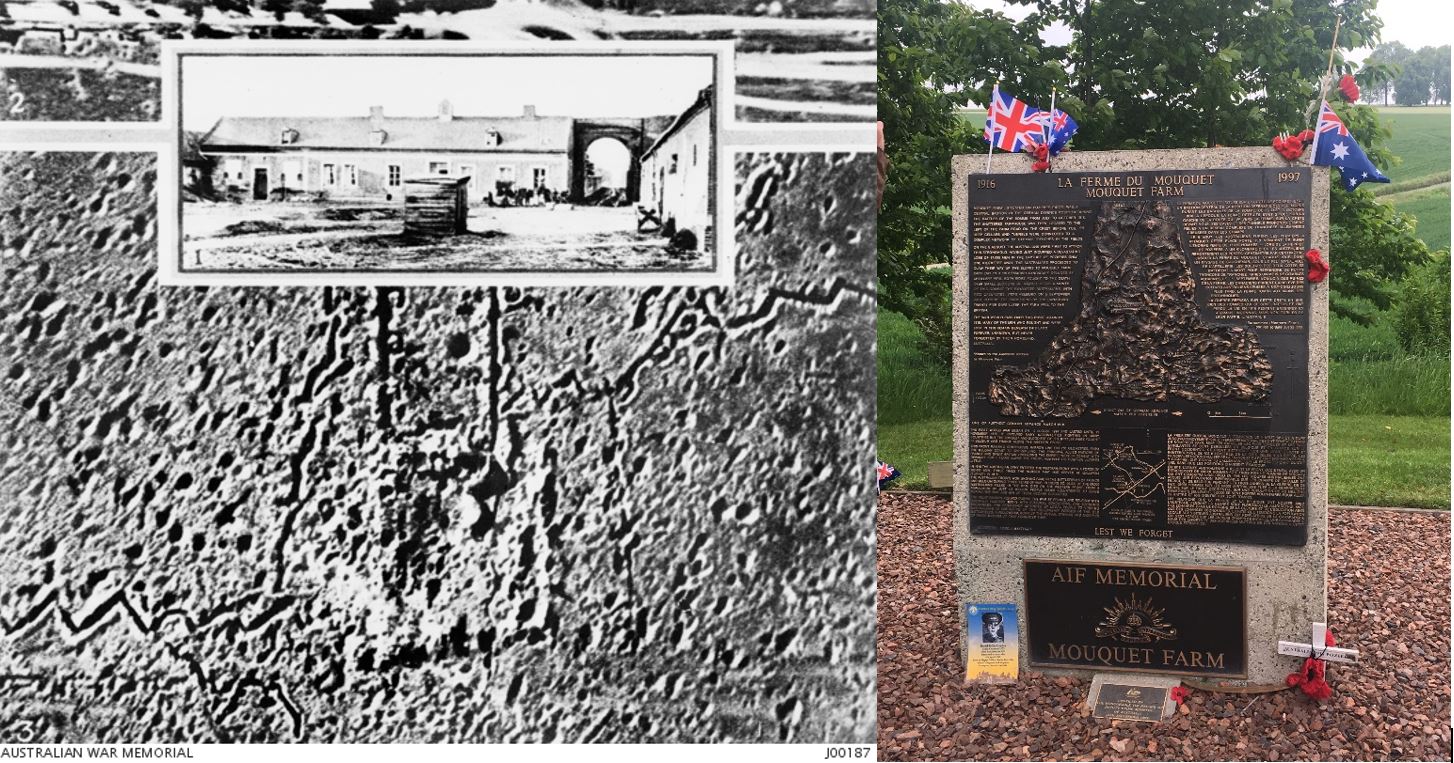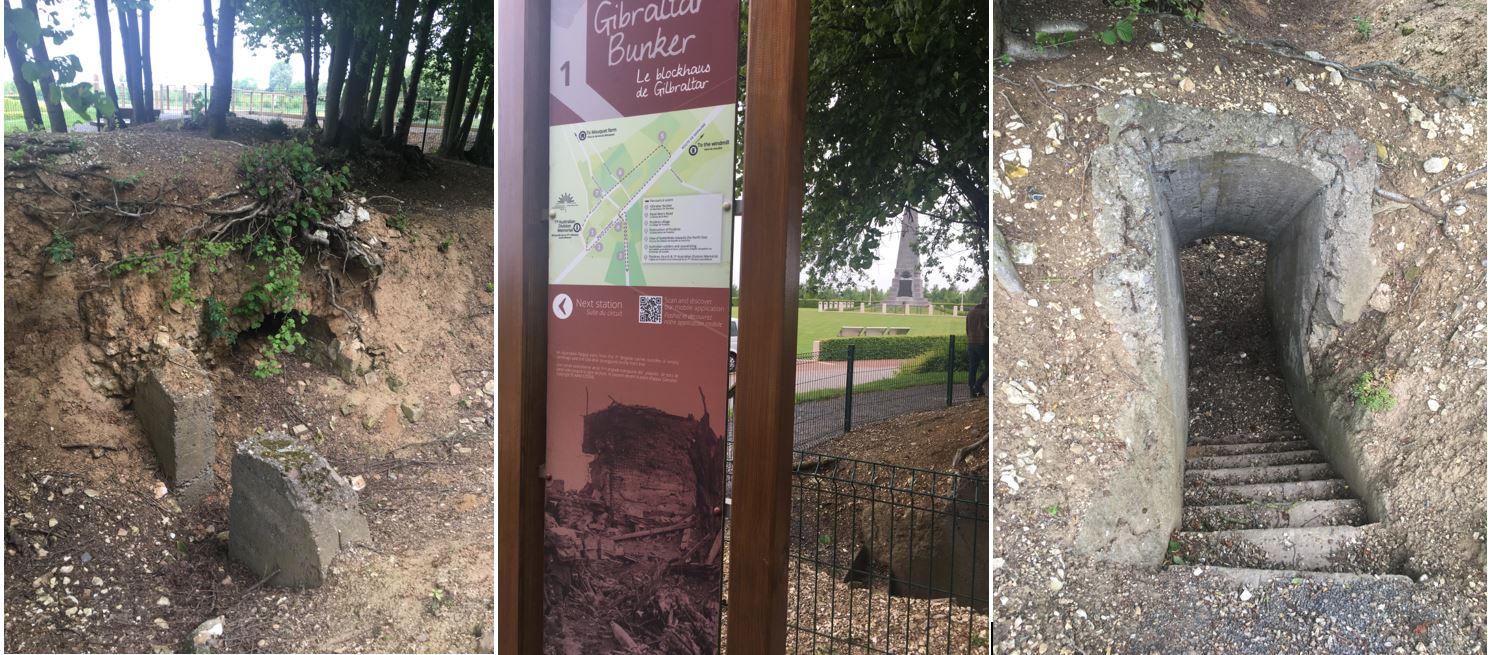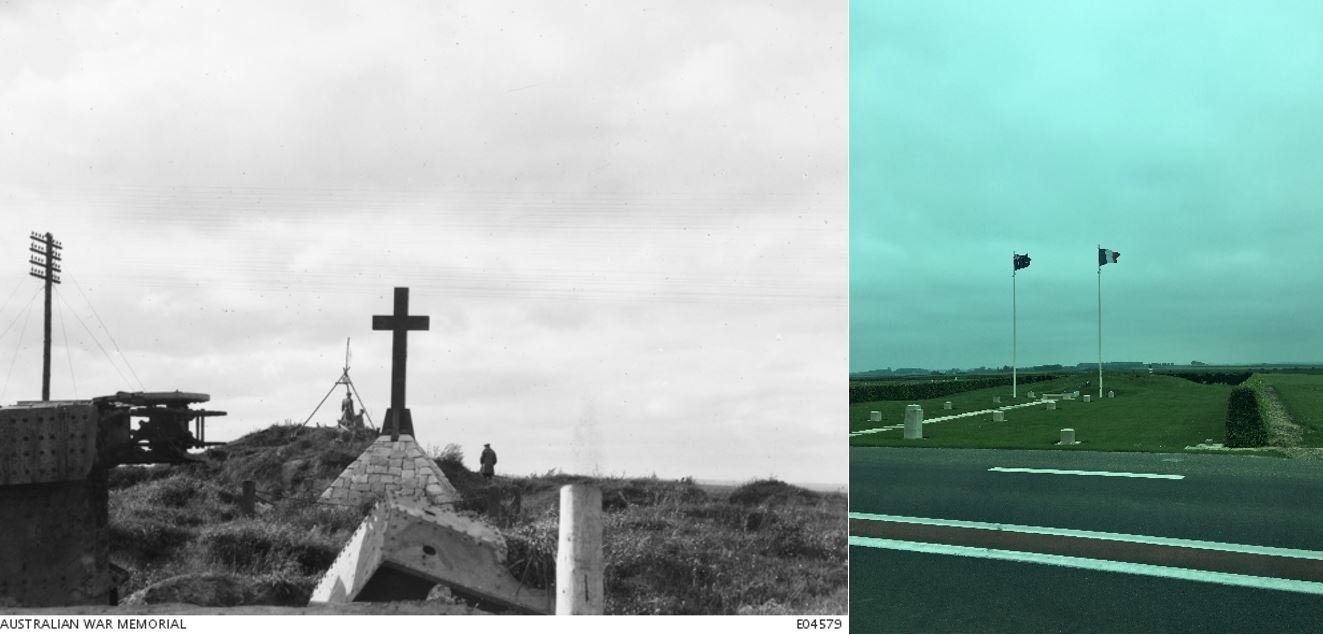 This water tower announced our arrival at Pozieres. A mother and daughter found amusement at the unexpected and unusual greeting. It’s good we Aussies can have a laugh at ourselves.
This water tower announced our arrival at Pozieres. A mother and daughter found amusement at the unexpected and unusual greeting. It’s good we Aussies can have a laugh at ourselves.
Devastation and new growth
The photographs below show the main street before the war and the lunar mud-scape resulting from artillery bombardment combing every inch of Pozières. The ground returned to its natural state as the front moved on.
 Locals and horse-drawn carriages on the Route Nationale, Pozieres, before the First World War. Concentrated German artillery bombardments in July and August 1916 completely razed the village, and, when the battle had passed, a notice board marked ‘Pozieres’ was the only indication that a village had ever been there. (Copied from a French postcard.) AWM C03126
Locals and horse-drawn carriages on the Route Nationale, Pozieres, before the First World War. Concentrated German artillery bombardments in July and August 1916 completely razed the village, and, when the battle had passed, a notice board marked ‘Pozieres’ was the only indication that a village had ever been there. (Copied from a French postcard.) AWM C03126
 The village of Pozieres as it was some months after the battle. The view is from the southern side of the main road looking southwards, east of the Copse. The lonely grave is that of Captain Ivor Stephen Margetts of Wynyard, Tas, who served in the 12th Battalion and was killed in action on 24 July 1916. The German Spring Offensive in 1918 re-captured this area and Margetts’ grave was obliterated and was lost. His name is commemorated on the Villers-Bretonneux Memorial. AWM E00532
The village of Pozieres as it was some months after the battle. The view is from the southern side of the main road looking southwards, east of the Copse. The lonely grave is that of Captain Ivor Stephen Margetts of Wynyard, Tas, who served in the 12th Battalion and was killed in action on 24 July 1916. The German Spring Offensive in 1918 re-captured this area and Margetts’ grave was obliterated and was lost. His name is commemorated on the Villers-Bretonneux Memorial. AWM E00532
 View of scattered Australian graves along the OG1 line on the battlefield of Pozieres. Twelve months before the area was a scene of heavy fighting and devastation; but when the fighting passed, the undergrowth flourished, and softened the appearance of utter desolation which marked the old battleground. AWM E00998
View of scattered Australian graves along the OG1 line on the battlefield of Pozieres. Twelve months before the area was a scene of heavy fighting and devastation; but when the fighting passed, the undergrowth flourished, and softened the appearance of utter desolation which marked the old battleground. AWM E00998
Then and now…
The village was obliterated from the face of the earth. Like most townships along the Western Front, it was completely rebuilt. Black and white photos from 1919 are contrasted with pictures taken on a guided day trip in 2019. I had not intended the photos for this purpose so excuse the non-perfect match-ups, taken in low light, sometimes from the minibus window.

 Top: Map by CEW Bean and below: contemporary map ( http://www.webmatters.net/index.php?id=111 )
Top: Map by CEW Bean and below: contemporary map ( http://www.webmatters.net/index.php?id=111 )
Mouquet farm
 Aerial view of Mouquet Farm, after shelling by British artillery, showing the ruins of the farm and destroyed trenches. Insert photograph of the exterior view of Mouquet Farm. AWM J00187 My photograph of the memorial plaque there.
Aerial view of Mouquet Farm, after shelling by British artillery, showing the ruins of the farm and destroyed trenches. Insert photograph of the exterior view of Mouquet Farm. AWM J00187 My photograph of the memorial plaque there.
 A view of the famous Mouquet Farm, north of the road from Courcelette. AWM E00006
A view of the famous Mouquet Farm, north of the road from Courcelette. AWM E00006
Gibraltar
 An Australian fatigue party from the 7th Brigade (far left) carrying piles of empty sandbags to the front line through the devastated area near Pozieres. The structure on the left is the remains of a German observation post, which stood on the western end of the village and was nicknamed ‘Gibraltar’ by the Australians. The post consisted of a concrete covered stairway down to a cellar from a house that formerly stood on the site and a larger, excavated chamber, and the whole housed three officers and 23 men. The occupants surrendered to a party from the 2nd Battalion on 23 July 1916 during the battle to wrest Pozieres from the Germans. Between 23 July and early September, the 1st, 2nd and 4th Divisions between them launched 19 attacks on German positions in and around the ruins of Pozieres. AWM EZ0098
An Australian fatigue party from the 7th Brigade (far left) carrying piles of empty sandbags to the front line through the devastated area near Pozieres. The structure on the left is the remains of a German observation post, which stood on the western end of the village and was nicknamed ‘Gibraltar’ by the Australians. The post consisted of a concrete covered stairway down to a cellar from a house that formerly stood on the site and a larger, excavated chamber, and the whole housed three officers and 23 men. The occupants surrendered to a party from the 2nd Battalion on 23 July 1916 during the battle to wrest Pozieres from the Germans. Between 23 July and early September, the 1st, 2nd and 4th Divisions between them launched 19 attacks on German positions in and around the ruins of Pozieres. AWM EZ0098 
The windmill and tank memorial


 Top: Source: https://www.digger-pozieres.org/the-association/ p(caption). Above: The 2nd Australian Divisional Memorial erected to the members of the Division who fell in the operations of July and August 1916. In the background three soldiers, probably Australian, are standing near the site of the Pozieres Windmill. Note on the left the remains of a tank. AWM E04579 Bottom right:Photo from the minibus: currend memorial.
Top: Source: https://www.digger-pozieres.org/the-association/ p(caption). Above: The 2nd Australian Divisional Memorial erected to the members of the Division who fell in the operations of July and August 1916. In the background three soldiers, probably Australian, are standing near the site of the Pozieres Windmill. Note on the left the remains of a tank. AWM E04579 Bottom right:Photo from the minibus: currend memorial.
 The derelict hulk of a British tank on the Pozieres battlefield…The Tank Corps Memorial, commemorating this action, is near the Windmill site on the Albert to Bapaume Road, just to the east of Pozieres, not far from where this photograph was taken. Source: The Tanks at Flers by Trevor Pidgeon, Fairmile Books Cobham, England. Pp 125-128 AWM P03631.210
The derelict hulk of a British tank on the Pozieres battlefield…The Tank Corps Memorial, commemorating this action, is near the Windmill site on the Albert to Bapaume Road, just to the east of Pozieres, not far from where this photograph was taken. Source: The Tanks at Flers by Trevor Pidgeon, Fairmile Books Cobham, England. Pp 125-128 AWM P03631.210
Aust 1st Div Memorial
 The memorial erected to commemorate the Australian soldiers of the 1st Division who fell during the capture of Pozieres in July 1916. The inscription on the cross reads ‘1st Australian Division AIF’. In front of the memorial are the graves of Bombardier D J Davies, killed in action; Bombardier F A Blackham, killed in action; Gunner G P Johnston, killed in action; Gunner O C Dalrymple, killed in action. AWM EZ0131
The memorial erected to commemorate the Australian soldiers of the 1st Division who fell during the capture of Pozieres in July 1916. The inscription on the cross reads ‘1st Australian Division AIF’. In front of the memorial are the graves of Bombardier D J Davies, killed in action; Bombardier F A Blackham, killed in action; Gunner G P Johnston, killed in action; Gunner O C Dalrymple, killed in action. AWM EZ0131
The Church

 Source: http://www.ww1battlefields.co.uk/pages/somme/pozieres.html
Source: http://www.ww1battlefields.co.uk/pages/somme/pozieres.html
The church at Pozieres, before the First World War. AWM C03110 The devastation on the site of the church in a village destroyed during the Somme Offensive. Between 23 July and early September 1916, the 1st, 2nd and 4th Divisions between them launched 19 attacks on German positions in and around the ruins of Pozieres. The Australians suffered 23,000 casualties while advancing two kilometres; British and Australian artillery were no match for German artillery and machine guns. AWM EZ0096
Tour lunch stop


Lochnagar crater

 The Lochnagar crater of an English mine at La Boisselle near Pozieres, the crater is 28 metres deep and 60 metres in diameter. A soldier is standing in the base of the crater next to a mass grave. The grave is surrounded by seven posts and on top of the grave are empty shells and a skull, a tin hat is on top of post near the skull. AWM A02784
The Lochnagar crater of an English mine at La Boisselle near Pozieres, the crater is 28 metres deep and 60 metres in diameter. A soldier is standing in the base of the crater next to a mass grave. The grave is surrounded by seven posts and on top of the grave are empty shells and a skull, a tin hat is on top of post near the skull. AWM A02784

Villers Bretonneux
Villers Bretonneux lists over 10,000 Australians who have no known grave in France


Next stop…
The Red Baron’s crash site. But that’s another story…
